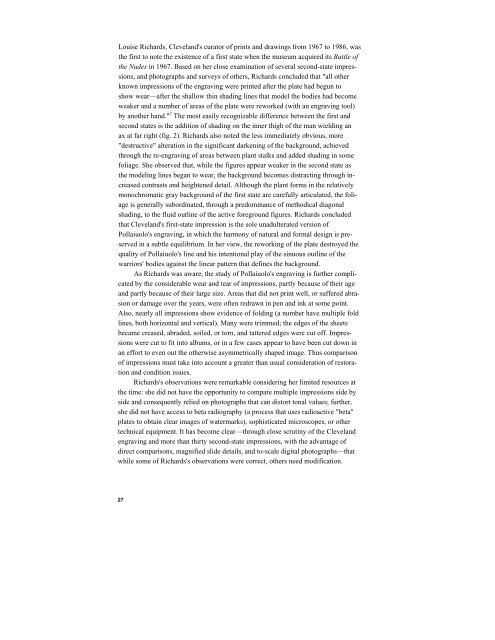Battle of the Nudes
Battle of the Nudes
Battle of the Nudes
Create successful ePaper yourself
Turn your PDF publications into a flip-book with our unique Google optimized e-Paper software.
Louise Richards, Cleveland's curator <strong>of</strong> prints and drawings from 1967 to 1986, was<br />
<strong>the</strong> first to note <strong>the</strong> existence <strong>of</strong> a first state when <strong>the</strong> museum acquired its <strong>Battle</strong> <strong>of</strong><br />
<strong>the</strong> <strong>Nudes</strong> in 1967. Based on her close examination <strong>of</strong> several second-state impres-<br />
sions, and photographs and surveys <strong>of</strong> o<strong>the</strong>rs, Richards concluded that "all o<strong>the</strong>r<br />
known impressions <strong>of</strong> <strong>the</strong> engraving were printed after <strong>the</strong> plate had begun to<br />
show wear—after <strong>the</strong> shallow thin shading lines that model <strong>the</strong> bodies had become<br />
weaker and a number <strong>of</strong> areas <strong>of</strong> <strong>the</strong> plate were reworked (with an engraving tool)<br />
by ano<strong>the</strong>r hand." 7 The most easily recognizable difference between <strong>the</strong> first and<br />
second states is <strong>the</strong> addition <strong>of</strong> shading on <strong>the</strong> inner thigh <strong>of</strong> <strong>the</strong> man wielding an<br />
ax at far right (fig. 2). Richards also noted <strong>the</strong> less immediately obvious, more<br />
"destructive" alteration in <strong>the</strong> significant darkening <strong>of</strong> <strong>the</strong> background, achieved<br />
through <strong>the</strong> re-engraving <strong>of</strong> areas between plant stalks and added shading in some<br />
foliage. She observed that, while <strong>the</strong> figures appear weaker in <strong>the</strong> second state as<br />
<strong>the</strong> modeling lines began to wear, <strong>the</strong> background becomes distracting through in-<br />
creased contrasts and heightened detail. Although <strong>the</strong> plant forms in <strong>the</strong> relatively<br />
monochromatic gray background <strong>of</strong> <strong>the</strong> first state are carefully articulated, <strong>the</strong> foli-<br />
age is generally subordinated, through a predominance <strong>of</strong> methodical diagonal<br />
shading, to <strong>the</strong> fluid outline <strong>of</strong> <strong>the</strong> active foreground figures. Richards concluded<br />
that Cleveland's first-state impression is <strong>the</strong> sole unadulterated version <strong>of</strong><br />
Pollaiuolo's engraving, in which <strong>the</strong> harmony <strong>of</strong> natural and formal design is pre-<br />
served in a subtle equilibrium. In her view, <strong>the</strong> reworking <strong>of</strong> <strong>the</strong> plate destroyed <strong>the</strong><br />
quality <strong>of</strong> Pollaiuolo's line and his intentional play <strong>of</strong> <strong>the</strong> sinuous outline <strong>of</strong> <strong>the</strong><br />
warriors' bodies against <strong>the</strong> linear pattern that defines <strong>the</strong> background.<br />
As Richards was aware, <strong>the</strong> study <strong>of</strong> Pollaiuolo's engraving is fur<strong>the</strong>r compli-<br />
cated by <strong>the</strong> considerable wear and tear <strong>of</strong> impressions, partly because <strong>of</strong> <strong>the</strong>ir age<br />
and partly because <strong>of</strong> <strong>the</strong>ir large size. Areas that did not print well, or suffered abra-<br />
sion or damage over <strong>the</strong> years, were <strong>of</strong>ten redrawn in pen and ink at some point.<br />
Also, nearly all impressions show evidence <strong>of</strong> folding (a number have multiple fold<br />
lines, both horizontal and vertical). Many were trimmed; <strong>the</strong> edges <strong>of</strong> <strong>the</strong> sheets<br />
became creased, abraded, soiled, or torn, and tattered edges were cut <strong>of</strong>f. Impres-<br />
sions were cut to fit into albums, or in a few cases appear to have been cut down in<br />
an effort to even out <strong>the</strong> o<strong>the</strong>rwise asymmetrically shaped image. Thus comparison<br />
<strong>of</strong> impressions must take into account a greater than usual consideration <strong>of</strong> restora-<br />
tion and condition issues.<br />
Richards's observations were remarkable considering her limited resources at<br />
<strong>the</strong> time: she did not have <strong>the</strong> opportunity to compare multiple impressions side by<br />
side and consequently relied on photographs that can distort tonal values; fur<strong>the</strong>r,<br />
she did not have access to beta radiography (a process that uses radioactive "beta"<br />
plates to obtain clear images <strong>of</strong> watermarks), sophisticated microscopes, or o<strong>the</strong>r<br />
technical equipment. It has become clear—through close scrutiny <strong>of</strong> <strong>the</strong> Cleveland<br />
engraving and more than thirty second-state impressions, with <strong>the</strong> advantage <strong>of</strong><br />
direct comparisons, magnified slide details, and to-scale digital photographs—that<br />
while some <strong>of</strong> Richards's observations were correct, o<strong>the</strong>rs need modification.<br />
27
















